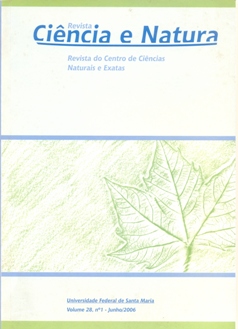Características dos Materiais da Coleta Seletiva de Resíduos Sólidos no bairro Camobi/Santa Maria/RS
DOI:
https://doi.org/10.5902/2179460X9666Resumo
O descarte de resíduos sólidos tem representado na atualidade um grave problema ambiental. Neste sentido, a reciclagem tem se apresentado como uma das alternativas viáveis para esta questão. Assim, objetiva-se com otrabalho observar as características dos materiais recicláveis entregues na coleta seletiva em duas áreas no bairro Camobi, Santa Maria - RS. As áreas amostraispossuem características socioeconômicas diferenciadas. Iniciou-se o processode coleta seletiva nas duas áreas experimentais, sendo a divulgação realizadacom uso de folheto informativo e de conversa com os residentes nas respectivas áreas. A coleta terá continuidade, porém os dados para a pesquisaforam coletados durante cinco semanas (entre maio e junho de 2003). A Associaçãodos selecionadores de material reciclável realizou a coleta e também a pesagem dos resíduos. Observou-se que não há diferenças significativas entreas duas áreas, quanto ao plástico e ao papel produzem praticamente amesma quantidade. As quantidades de sucata e alumínio foram mais expressivas na área com menor poder aquisitivo, porém o vidro é mais representativo na área de maior poder aquisitivo. Observou-se que na área com maior poder aquisitivo houve um crescimento contínuo na contribuição de material reciclável.Downloads
Downloads
Publicado
Como Citar
Edição
Seção
Licença
Para acessar a DECLARAÇÃO DE ORIGINALIDADE E EXCLUSIVIDADE E CESSÃO DE DIREITOS AUTORAIS clique aqui.
Diretrizes Éticas para Publicação de Revistas
A revista Ciência e Natura está empenhada em garantir a ética na publicação e na qualidade dos artigos.
A conformidade com padrões de comportamento ético é, portanto, esperada de todas as partes envolvidas: Autores, Editores e Revisores.
Em particular,
Autores: Os Autores devem apresentar uma discussão objetiva sobre a importância do trabalho de pesquisa, bem como detalhes e referências suficientes para permitir que outros reproduzam as experiências. Declarações fraudulentas ou intencionalmente incorretas constituem comportamento antiético e são inaceitáveis. Artigos de Revisão também devem ser objetivos, abrangentes e relatos precisos do estado da arte. Os Autores devem assegurar que seu trabalho é uma obra totalmente original, e se o trabalho e / ou palavras de outros têm sido utilizadas, isso tem sido devidamente reconhecido. O plágio em todas as suas formas constitui um comportamento publicitário não ético e é inaceitável. Submeter o mesmo manuscrito a mais de um jornal simultaneamente constitui um comportamento publicitário não ético e é inaceitável. Os Autores não devem submeter artigos que descrevam essencialmente a mesma pesquisa a mais de uma revista. O Autor correspondente deve garantir que haja um consenso total de todos os Co-autores na aprovação da versão final do artigo e sua submissão para publicação.
Editores: Os Editores devem avaliar manuscritos exclusivamente com base no seu mérito acadêmico. Um Editor não deve usar informações não publicadas na própria pesquisa do Editor sem o consentimento expresso por escrito do Autor. Os Editores devem tomar medidas de resposta razoável quando tiverem sido apresentadas queixas éticas relativas a um manuscrito submetido ou publicado.
Revisores: Todos os manuscritos recebidos para revisão devem ser tratados como documentos confidenciais. As informações ou ideias privilegiadas obtidas através da análise por pares devem ser mantidas confidenciais e não utilizadas para vantagens pessoais. As revisões devem ser conduzidas objetivamente e as observações devem ser formuladas claramente com argumentos de apoio, de modo que os Autores possam usá-los para melhorar o artigo. Qualquer Revisor selecionado que se sinta desqualificado para rever a pesquisa relatada em um manuscrito ou sabe que sua rápida revisão será impossível deve notificar o Editor e desculpar-se do processo de revisão. Os Revisores não devem considerar manuscritos nos quais tenham conflitos de interesse resultantes de relacionamentos ou conexões competitivas, colaborativas ou outras conexões com qualquer dos autores, empresas ou instituições conectadas aos documentos.






